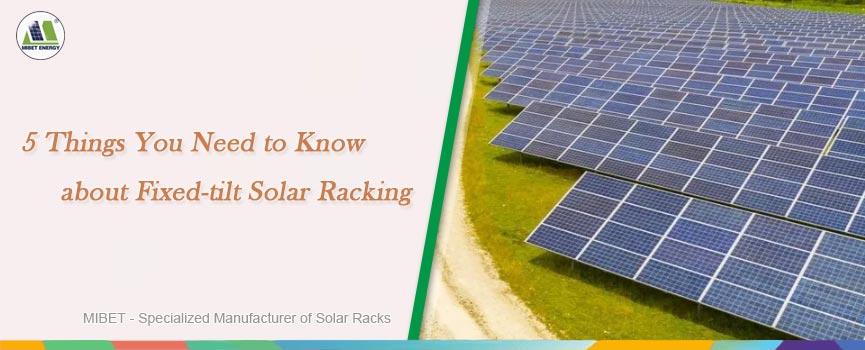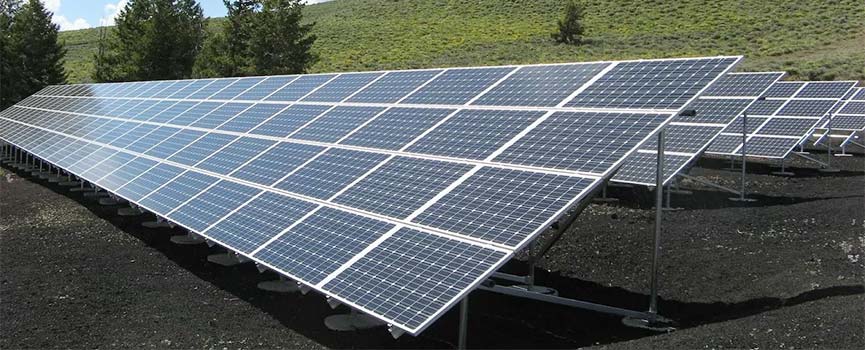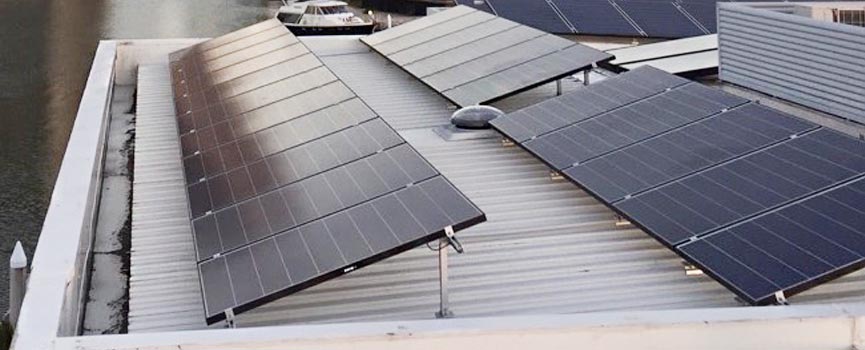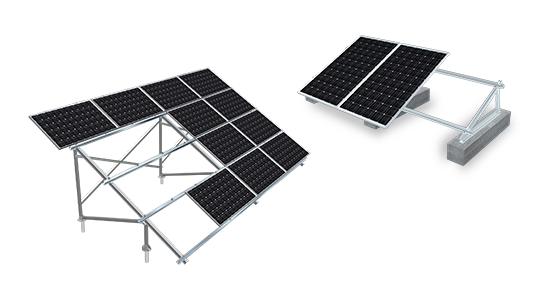5 Things You Need to Know about Fixed-tilt Solar Racking

Solar panels are tilted to increase their exposure to sunlight, thereby capturing more solar energy. Increased exposure to sunlight means more energy generation for homes or businesses. While tracking solar systems have gained popularity in recent years, a significant portion of large-scale utility solar capacity still relies on fixed-tilt solar racking systems. The article will introduce several vital points you need to understand.
What Is a Fixed Tilt System?
A fixed tilt system is a type of solar panel installation in which the solar panels are mounted at a fixed angle and orientation, typically facing south to maximize sunlight exposure.
The tilt angle is fixed at a specific angle, usually determined by the location of the installation and the seasonality of the sun's path. This type of solar panel installation is simple and cost-effective, as it requires less equipment and maintenance compared to other types of solar panel systems.
Fixed tilt arrays are commonly used in large-scale commercial and utility-scale solar installations, where the primary goal is to generate the maximum amount of energy at the lowest possible cost.
The amount of electricity generated by a fixed-tilt solar racking system depends on the orientation of the solar panels relative to the sun. The solar array panels collect solar radiation more efficiently when the sun's rays are perpendicular to the panel. So, the tilt angle of fixed-tilt solar array should be designed according to the geographical location. For example, at lower latitudes, in states such as Hawaii, the sun is higher in the sky and solar panels do not require much direct sunlight; but at higher latitudes, in states like Minnesota, the sun is lower in the sky and solar panels are often installed at greater tilt angles to receive direct sunlight.
Optimal Solar Panel Angle
The tilt of solar panels is a critical factor in their energy output. The ideal angle varies based on the geographic location, time of day, and season, influencing the amount of sunlight the panels receive and, in turn, their electricity production.
When set at the right angle, solar panels can efficiently harvest the most sunlight. However, angles that are either too steep or too flat will reduce sunlight capture and energy generation.
The optimal solar panel angle for a fixed-tilt solar racking system depends on the latitude of the location where the system is installed. In general, the optimal angle is equal to the latitude plus 15 degrees. For example, the optimal angle for a system installed in Los Angeles, California (latitude 34 degrees) would be 49 degrees.
It's also important to consider seasonal changes. In summer, when the sun is higher, a less steep angle might be more effective. In winter, a steeper angle can be beneficial to maximize energy capture. To identify the best tilt angle for your needs, consulting with a professional solar panel installer is advisable.
Factors That Affect Solar Panel Angle

Latitude
The optimal angle for a solar panel is based on your location's latitude. For instance, in the UK, with a latitude range of approximately 49 to 59 degrees, the ideal tilt angle for solar panels falls between 30 and 40 degrees.
Time of Year
As the sun's angle shifts throughout the year, the optimal tilt for solar panels also changes. A general rule is to set the panels at an angle equal to the local latitude for consistent performance all year.
To enhance winter energy production, increasing the tilt by 10-15 degrees can capture more sunlight when the sun is lower. Conversely, for better summer output, such as for cooling needs, decreasing the angle by 10-15 degrees can be beneficial during months with a higher sun angle.
Type of Solar Panel Installation
The solar panel installation type also plays a role. Roof-mounted systems usually follow the roof's pitch. Flat roofs need mounting structures to position the panels at the ideal angle. Ground-mounted systems offer flexibility to adjust the tilt based on latitude and seasonal variations.
Fixed-tilt Solar Racking VS Tracking System
The choice between fixed-tilt solar racking and tracking systems depends on various factors specific to each project. While solar trackers can enhance the efficiency of a PV system, their suitability hinges on several conditions. Undulating terrain, steep slopes, limited space, and immovable obstacles may necessitate fixed-tilt systems. In such cases, a combination of fixed-tilt and tracker systems could provide a viable solution.
When selecting the appropriate system, project-specific variables must be considered. Solar trackers are more susceptible to weather-related disruptions, necessitating higher maintenance costs. Consequently, they are most suitable for regions with ample irradiation. Fixed-tilt systems, on the other hand, can operate effectively in cloudy regions, maximizing energy production.
Overall project costs play a crucial role in the decision-making process. Trackers, particularly dual-axis ones, incur significant upfront costs. However, if the PV project can reap long-term financial benefits from increased energy generation, trackers may be a worthwhile investment. Conversely, fixed-tilt systems are more cost-effective for smaller-scale projects due to their lower construction and maintenance expenses.
While single-axis tracker systems can significantly boost energy production, the additional installation and maintenance costs must be carefully evaluated. Fixed-tilt systems generally have lower capital costs and overall performance compared to trackers. When considering both fixed and variable costs, the levelized cost of energy (LCOE) for a single-axis tracking system may, in many cases, exceed that of a fixed-tilt system.
Additionally, fixed-tilt racking systems typically incur fewer long-term operational costs due to the absence of moving parts, associated electronics, and drivetrains. While regular maintenance, including vegetation management, snow removal, and cleaning, is required for both systems, single-axis tracking systems demand additional specialized professional maintenance, driving up overall costs.
Where Can the Fixed-Tilt Racking System Be Installed?

Fixed-tilt racking systems are versatile and can be installed in various settings, each offering unique benefits. On rooftops, both residential and commercial, these systems are tailored to optimize the solar panels' tilt angle based on the building's location and the site's latitude. This optimal tilt enhances the efficiency of solar energy capture. Ground mounts, typically chosen for larger solar projects such as those powering businesses or utilities, provide ample space for extensive solar arrays.
Additionally, slopes offer an interesting option for solar installations, as their natural inclination can be advantageous for achieving the ideal tilt angle, maximizing solar exposure. Carports, too, are an increasingly popular choice for fixed-tilt solar installations. They not only generate electricity but also offer the practical benefit of shading parked vehicles. The choice of location for these systems is influenced by factors like available space, desired tilt angle, and compliance with local building codes, ensuring an efficient and suitable installation.
Advantages of Fixed Tilt Solar Panel Racking
1. Simplicity and cost-effectiveness: Fixed-tilt systems are the simplest and most cost-effective type of solar mounting system. They do not require tracking motors or other complex components, which reduces the upfront cost and ongoing maintenance requirements.
2. Durability and reliability: Fixed-tilt systems are very durable and can withstand harsh weather conditions, such as high winds, heavy snow, and extreme temperatures. They are also less susceptible to mechanical failures than tracking systems.
3. Ease of installation: Fixed-tilt systems are relatively easy to install, even for non-professionals. This can save time and money on installation costs.
4. Low maintenance: Fixed-tilt systems require very little maintenance. The panels are fixed in place and do not require regular adjustments.
5. Suitable for a variety of locations: Fixed-tilt systems can be installed on rooftops, ground mounts, and slopes. They are a versatile option for a wide range of applications.
6. Compatible with various panel sizes: Fixed-tilt systems can accommodate multiple panel sizes and configurations. This makes them a flexible option for different project requirements.
7. Fixed-tilt systems excel in diverse topographies: Fixed-tilt mounting systems adapt well to varying terrains, including slopes and rolling hills, making them suitable for challenging sites with obstructions or geotechnical constraints.
How Can Mibet Help
The success of your solar investment depends greatly on the quality of the mounting solutions you choose. The mounting systems' reliability directly impacts your solar plant's overall performance. Our provides durable solar mounting systems made from high-quality aluminum or steel. These systems are designed for strength and minimal maintenance, and they deliver reliable performance even in harsh conditions. This durability is a key factor in ensuring the long-term success of your solar investment.


